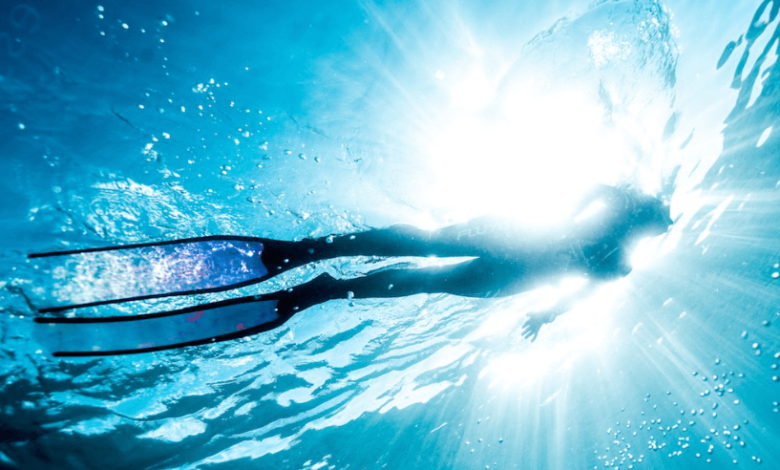What Are Freediving Fins?

Freediving is a thrilling underwater activity that challenges divers to hold their breath while exploring the depths of the ocean. To maximise efficiency and extend dive times, freedivers rely on specialised equipment, with freediving fins being one of the most essential pieces. These fins are designed to provide superior propulsion and reduce oxygen consumption, allowing divers to move smoothly through the water with minimal effort.
Freediving fins differ significantly from snorkelling and scuba fins due to their length, flexibility, and performance. Understanding how freediving fins work and choosing the right type can greatly enhance a diver’s underwater experience.
What Are Freediving Fins?
Freediving fins are long-bladed fins designed to propel divers efficiently while using minimal energy. They are much longer than traditional snorkelling or scuba fins, offering better thrust and reducing the number of kicks required to move through the water. The increased surface area of freediving fins allows divers to conserve oxygen, extending their time underwater.
Unlike scuba fins, which are shorter and stiffer, freediving fins are designed to be flexible and responsive. This flexibility enhances propulsion, making it easier for divers to descend and ascend smoothly without exerting too much energy.
See also: How Do Clear Braces Differ from Traditional Braces?
How Do Freediving Fins Work?
Freediving fins work by converting the energy from a diver’s leg movements into forward propulsion. The long, flexible blades generate greater thrust, allowing divers to move through the water efficiently while reducing the need for frequent kicks.
Key Factors That Enhance Fin Performance:
- Blade Length and Flexibility – Longer blades provide more thrust and require fewer kicks, conserving energy and oxygen.
- Foot Pocket Design – A snug fit ensures maximum energy transfer from the legs to the blade, improving overall efficiency.
- Material Composition – The type of material (plastic, fibreglass, or carbon fibre) impacts the responsiveness and performance of the fins.
Types of Freediving Fins
Plastic Freediving Fins
Plastic fins are the most affordable and durable option for beginners. They are resistant to damage and can withstand harsh underwater conditions. However, they are heavier and less responsive than other materials, making them less efficient for deep dives.
Fibreglass Freediving Fins
Fibreglass fins offer a balance between durability and performance. They are more flexible and efficient than plastic fins, allowing for better propulsion and reduced energy consumption. Fibreglass fins are a great choice for intermediate and advanced freedivers who want improved performance without the higher cost of carbon fibre fins.
Carbon Fibre Freediving Fins
Carbon fibre fins are the top choice for experienced and professional freedivers. They are lightweight, highly responsive, and offer superior performance in terms of thrust and energy efficiency. While they are the most expensive option, carbon fibre fins provide unmatched control and reduce fatigue during long or deep dives.
For those looking for high-quality freediving fins, a variety of options are available, catering to different skill levels and preferences.
Choosing the Right Freediving Fins
Blade Material and Stiffness
The choice of blade material directly impacts performance. Beginners may prefer plastic fins for durability, while more experienced divers benefit from the flexibility of fibreglass or carbon fibre. Stiffer blades offer more propulsion but require stronger kicks, making them suitable for advanced freedivers.
Foot Pocket Fit and Comfort
A proper fit is essential to prevent water from entering the foot pocket and to maximise energy transfer. Full-foot pockets are common in freediving fins and should fit snugly without causing discomfort. Wearing neoprene socks can improve the fit and prevent blisters.
Fin Length and Blade Design
Longer blades provide better propulsion but require more control and technique. Beginners should opt for medium-length blades, while advanced freedivers often prefer longer fins for maximum efficiency in deep dives.
Benefits of Using Freediving Fins
Increased Propulsion and Efficiency
Freediving fins generate greater thrust, allowing divers to cover longer distances with fewer kicks. This efficiency reduces the energy needed to move through the water, conserving oxygen and extending dive time.
Reduced Oxygen Consumption
The design of freediving fins minimises the effort required to propel through the water. This reduces oxygen consumption, allowing divers to stay underwater longer and dive deeper.
Improved Control and Manoeuvrability
Freediving fins provide better control over movements, making it easier to navigate underwater environments. Divers can glide smoothly while maintaining stability, which is essential for deep dives and exploring marine life.
How to Care for Freediving Fins
Rinse with Fresh Water
Always rinse freediving fins with fresh water after each dive to remove salt, sand, and other debris. This prevents material degradation and prolongs the lifespan of the fins.
Store Properly
Store fins flat or upright to prevent warping or bending. Avoid placing heavy objects on the fins and keep them in a cool, dry place away from direct sunlight.
Avoid Direct Sunlight
Exposure to sunlight and high temperatures can damage the blade material and reduce the flexibility of the fins. Storing the fins properly ensures they maintain their performance and longevity.
Common Mistakes to Avoid
Using Improper Kicking Techniques
Incorrect kicking techniques can lead to fatigue and reduced efficiency. Slow, steady, and relaxed kicks are the most effective for freediving.
Choosing the Wrong Fin Size
Fins that are too tight cause discomfort, while loose fins allow water to enter the foot pocket, reducing efficiency. Ensure a proper fit for optimal performance.
Neglecting Maintenance
Failure to rinse and store fins properly can lead to premature wear and tear. Regular maintenance ensures that the fins remain in top condition for years to come.
Conclusion
Freediving fins play a vital role in improving propulsion, conserving energy, and extending dive times. By choosing the right fins based on skill level, material, and fit, freedivers can enhance their overall performance and safety underwater. Proper care and maintenance ensure that fins last longer and continue to provide optimal performance. Whether you’re a beginner or an advanced freediver, investing in high-quality freediving fins can significantly improve your underwater experience.







